| NEWS |
|
|
| BADGES |
|
|
| ROMFORD DISTRICT |
|
|
| FEATURES |
|
|
| SONGS |
|
|
| FORMS |
|
|
| LINKS |
|
|
| WEB SITE |
|
|
|
 |
 |
1950 |
|
JANUARY WINTER CAMP |
| 
|
| The year started with a Winter Camp in January at the group's Navestock camp site. The camp report consists of a set of cartoons drawn by the campers. They reveal a detail about the hut that isn't obvious from any of the surviving photos. It appears to have previously belonged to the London North Eastern Railway. |
| 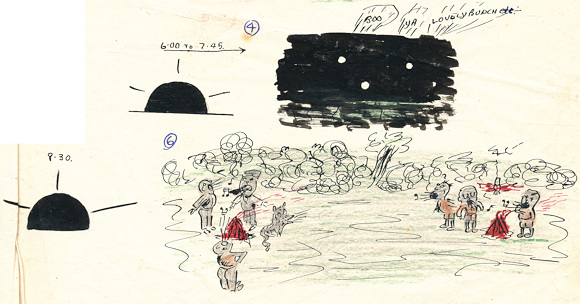
|
| By deciphering the depictions we can deduce the following. It appears that the Scouts cycled to camp carrying their kit in rucksacks. The first Scout arrived at 3:00pm and had a fire going with a billy of water on it by 3:15. The last Scout arrived at 4:00pm with two flat tyres. It was dark by 6:00pm but the singing began shortly after. By 8:00pm the troop were in full voice and a lamp had been found. By 8:30 there were two fires with two small groups of Scouts and a one dog singing around them. Prayers were said at 9:00pm. It is assumed they slept in the hut as no tents are depicted.
They were up at 06:30 and were greeted by a red sky. Exercises were conducted at 08:00am followed by more cycling and lunch cooked on the fire at 1:00pm. They left to cycle home between 4 and 5:30pm. The camp was attended by Bo’sun (Ted Butcher) and six Scouts, John Paisley, David Hunt, Bill Girlwood, Gerald Marwood, John and David Sixsmith. |
| 
|
ANNUAL REPORT
The group annual report for 1950 includes reports from ex scouts including Dr Tony Levy who has accepted an offer to setup a research department of his own at the University of California. All the Scout leaders in the troop were noted as also working in other groups with Boísun E. Butcher now Scout Master of 1st Harold Hill. Doubling up wasnít limited to the leaders either, three of the Scouts were also members of other troops.
We had 48 Scouts in the troop plus another 4 away on national service. Eight of the Scouts had gained their first class awards during 1950 bringing the troop total at the time to 23 which was 10% of the first class scouts in the entire county.
The 2nd class award was at this time regarded as basic training by Scouts and needed to be completed within one year of joining. With ten of our Scouts having passed the 2nd class award 3GP had a relatively highly trained troop enabling us to partake in some ambitious camping.
As well as the January camp, the groupís site at Navestock was used at Easter for a ten day camp for our younger Scouts led by the Cuckoo's Patrol Leader. The rest of the troop became the first UK Scouts ever to camp in Sicily and we were the first that year to camp in Italy. The Romford Recorder from Friday April 21st 1950 had a detailed report written by F.W. Rowswell running to three and a half columns covering the escapade. A summarised version can be read on our Summer Camp Page. A note regarding this camp also appeared in the Easter Sunday edition of the Sunday Times. Summer camp took place at Bryn Moel Llanycil Bala in Wales and a report of that is also in our Summer Camp Section.
In total four camps were held that year which enabled Derek Hayward to become the 6th member of the 3rd Gidea Park 100 club having completed over 100 nights .
The swimming gala at this time was held on Thursday evenings which Mr Rowswell felt was a disadvantage for 3GP as our members struggled to attend our weekly meetings let alone a 3 hour gala. However 3GP still managed to win the district gala by an increased margin. The troop went on to provide half the swimmers for the district team which won the county gala.
The report for 1950 ends by explaining that the early Easter of 1951 means that not all Schools were scheduling the Easter break at the same time and so not all Scouts would be able to participate in the booked trip to the Italian Riviera. This seems to be part of the motivation for booking a second foreign camp in 1951, this time in July to the Arctic Circle. The trouble was, the 1951 festival of Britain was proving so popular with Scandinavians that it was difficult to book cheap passage across the North Sea.
The December 1950 Parish Magazine describes how the Scouts spent Autumn weekends on a "festival of cooking" which included grouse and other birds as well as scones and sweet dishes, all cooked on open fires. During September the troop had visited Hampton Court to visit the palace gardens and row on the Thames. The article concludes with details of the 1951 camp to the Italian Riviera and how parents are welcome to travel with the Scouts taking advantage of the cheap group travel arrangements but staying in hotels.
|
|
|
 |
 |
|
 |
 |
 |
1951 |
|
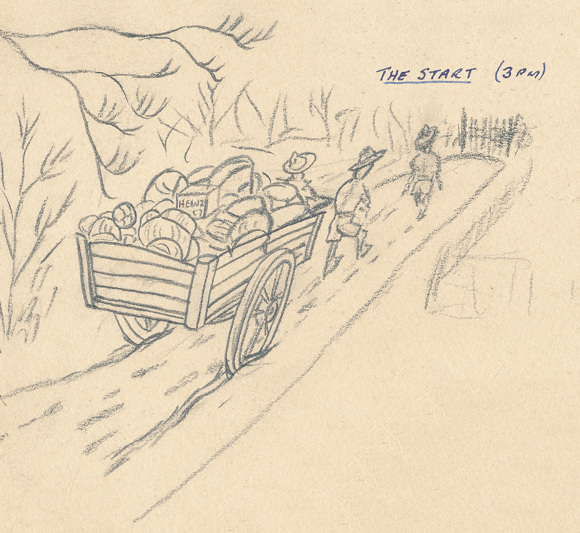 |
We don't have many photos from the late forties or early 50s but we do have sketches. The above is from the 1951 January Camp at our Navestock site. What makes it particularly interesting is it depicts what was probably the group trek cart. This may be the only depiction in our archive of where that red cartwheel, which to this day, 70 years later still clutters up our store.
|
 |
The pictorial depicts a 4:50am moonlight football match and it looks like the journey home with trek cart was also undertaken in the dark. |
The Annual report for 1951 explains that it was another successful year of camping with five more Scouts joining the 3GP 100 nights away club. That made eleven in total, eight in the six years since the end of the war. The five new members were Ian Frost, David Hunt, Michael Jones, Allen Matthews and Malcolm Pattrick. News from old members included that our first troop leader Roger Murley was now happily married in Venezuela and that David Wellington had left California University to serve with the US forces in Korea.
On the leader front, Mr. A Smith had to retire from the role of Cub Master but formed what looks like the first Group executive committee and was voted in as its first secretary. Mr W. Clay became the new Cub leaders but seems to have had no assistants. In 1950 it was reported that the 3GP Assistant Scout Leaders were all helping other troops. By 1951 it seems the other troops were taking priority over 3GP and we needed new assistant leaders to replace them. Mr Rowswell was back in the familiar situation of being the sole Scout Leader.
During the year, it seems all of the elite Cobra patrol left Gidea Park to become farmers however they still returned to the troop on vacation. Including the partly absent Farmers, the troop membership was now at 50. 22 were first class and 18 second class. Half the troop were over the age of 14 and 1/3 over 15.
SWIMMING
Mr Rowswell noted that in 1951 the number of Scouts gaining Royal Life-saving society awards was down on previous years and more effort would required in 1952. They still managed to reach a total of 40 Scouts having gained one or more awards since 1948.
Swimming training was still paying off in terms of district gala results. Mr Rowswell outlined progress as follows.
- 1946 – Scored 6 points only.
- 1947 – missed cup by 3 points only.
- 1948 – missed by 1 point only.
- 1948 – won by 8 points,
- 1950 – won by 9 points,
- 1951 – won by 13 points with a total of 34.
Unlike today, our leaders were able to take great pride in our gala achievement because the boys had largely learnt to swim through the Scouts. The County neglected to hold a gala in 1951 but that could be because the unbeatable Romford District had held the trophy for 25 years.
|
CAMPING
When it comes to Camping, the troop rather excelled itself in 1951. In April we camped on the Italian Riviera, but five Scouts also camped at the Navestock campsite at Easter. |
| |
|
|
 |
 |
|
 |
 |
 |
1952 |
|
|
The Group annual report for 1952 starts by explaining that the great event for the year was our first stage presentation. On May 16th the whole group took part in a presentation of Ralf Reader’s “We’ll Live for Ever” at the Lambourne Hall. 600 people paid to see this performance and photos appeared in the local press. Later in the year some of our group took part in the District Show. The St Michael’s Guides also assisted in the show.
|
|
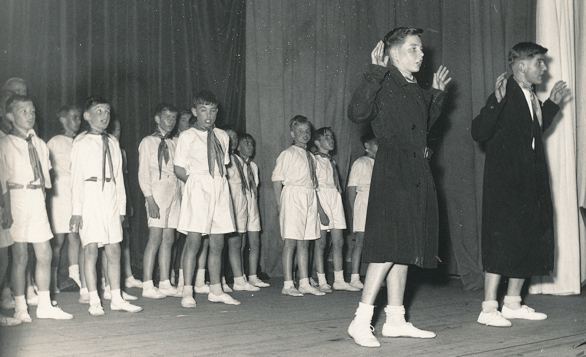
PHOTO: A.F. Hambleton - "Don't Be Afraid of the Rain" Paul and Allen Matthews & Chorus
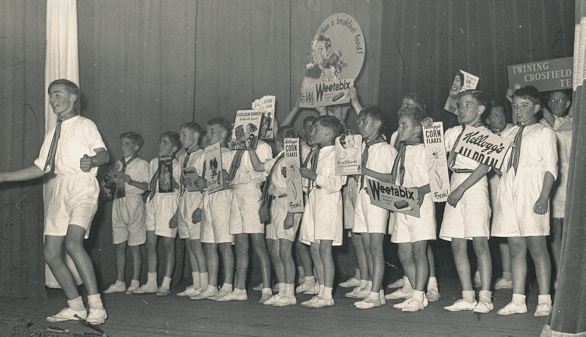
PHOTO: A.F. Hambleton - "Advertise" Alan Jones & Chorus

PHOTO: A.F. Hambleton - "Finale"
|
|
Mr A. E. Hobson produced our show and subsequently during 1952 became an Assistant Scout Leader and acting Rover Leader. Meanwhile our retired Cub-master and inaugural Group Secretary Mr Smith had married a Miss Pauline Jones and appeared to move to East Dulwich.
4 Members of the Cobra patrol were invested as Rover Scouts but including those four, we had 51 invested Scouts, 23 were First Class and 23 2nd. The average age was over 14. 14 Second class badges were gained during 1952 but due to the focus on putting on the show only 3 first class.
Roger Bell, Colin Banks, Paul Mathews and Norman Meakins all joined the 100 nights away club and Allen Matthews was noted as setting a probable record for a UK scout for distance travelled to and from camp with a total of 16,000 miles with the Troop.
Two of our cubs, David Goss and John Clay were mentioned in national and Local newspapers for finding and tracking an alleged housebreaker on June 15th.
SPORTS
The District revived its own Scout swimming club which helped us gain even more Royal Lifesaving Society Awards. During 1952, 8 Scouts gained the Bronze medallion and 8 the Intermediate level which meant that 40 members of the present troop held one or more awards.
Both the Troop and Pack won. The troop gained fewer points than in 1951 but this was possibly due to the re-establishment of the District club. Mr Rowswell commented on the improved standards of the opposition. The Margin of Victory was still 14 points and the total troop score of 30.5 was still higher than any other troop has ever managed.
The Troop also won the district Scout Sports cub in 1952 with a margin of 6.
CHURCH PARADE
The February parade fell on the Sunday after King George’s passing. The Colour Parties advanced to the alter in solemn step with flags dipped and draped. At this time it was custom for Scouts to be invested after Church parade and Rodney Panting became the 1st Member of 3GP to make his promise to “God and the Queen” It seems that Rover Scouts were invested in the Lady Chapel.
In the accounts it is noted that a Gestetner rotary duplicating press was kindly presented to the group by Radio Luxemburg.
MR ROWSWELL'S TROOP
During 1952 the Chief Scout visited Scouts in Ilkley in Yorkshire. He realised that he recognised the Assistant Scout Master Roger Mathews. Roger explained to him that they had met four years previously when the Chief Scout had visited the Brentwood School and 3rd Gidea Park troops at the School. At this, the Chief Scout replied “oh yes, I know - Mr Rowswell’s Troop” |
|
|
 |
 |
|
 |
 |
 |
1953 |
|
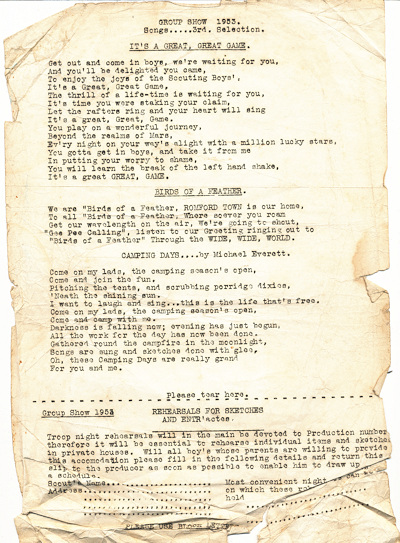 |
The letter on the left was sent to group members in 1953. It contains the lyrics of three songs to be sung at the Group Show that year.
At the bottom it explains that “Troop night rehearsals will in the main be devoted to production numbers”; and so smaller numbers will need to be rehearsed in peoples houses. It is asking parents to indicate what evenings they would be willing to allow small groups of Scouts to rehearse. |
|
 |
We have a program from the Gang Show in the Group Archives. The program contains a cast list, adverts for various local companies including Gidea Park Motors LTD (Telephone Romford 66) and The Newsbox.
In the list of thank-yous we find:
- The Brownies of St Michael's for kindly lending us their uniforms. (This would have been for "Bashful Brownies")
- Pinewood Film Studios for the loan of a ships wheel.
At the very back is an appeal for a building for the Rovers to meet in. |  |
|
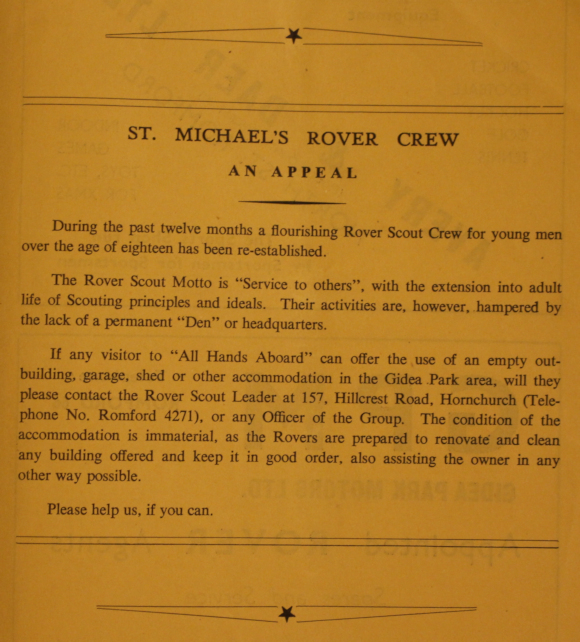 |
 |
|
The Cub Pack performing Bashful Brownies at the 1953 Gang Show.
LEADERS
The report for the year starts with the news that we had an assistant cub master at last in the shape of Mr Peter Wall and two additional assistant Scout masters in Alan Tomes and Michael Everett although Alan departed on national service during the year.
|
|
ROVER CREW
The crew now had 20 members including our Scouters and some who were registered with other groups. Albert Hobson was the Crew leader and meetings had been taking place in members houses until a Den was obtained. Mr Thompson of Arden Cottage, Junction Road had kindly allowed the use of a shed in his garden for this purpose. Leslie Page had taken on the role of Rover Mate from John Paisley and Michael Everett.
During the year the Crew helped at the county camp for disabled Scouts, cooked for the District Patrol Leaders Camp at Gilwell and collected for the Greek Earthquake Fund.
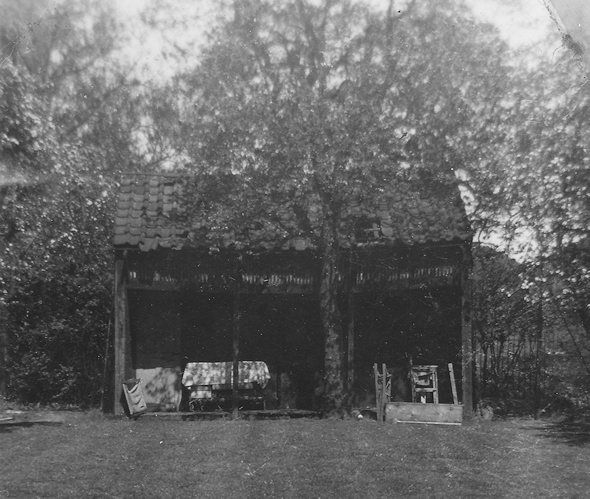
A picture of the building that would become the crew den before the Rovers got their hands on it.
To the right can just be made out the Lodge Farm Park fence.
GROUP EXECUTIVE
The Committee had arranged a second show as well as Whist Drives and a Jumble Sale. The 2nd Gang Show entitled “All Hands Aboard” was produced by Albert Hobson and Michael Everett. It included Solo, duet and Trio performances as well as the usual group numbers.
TROOP MEMBERS
3GP had 51 invested Scouts arranged in seven patrols. 20 were first class including 3 Queens Scouts and another 20 were second class. Mr Rowswell commented that 3GP was averaging about 1 Queens Scout per year. It doesn’t sound much but against a national backdrop of only about 30 per year it looks quite good. The number of first and second class Scouts is down on the previous year partly due to a continued focus on the gang shows and partly because Scouts started moving on to Rovers at a slightly younger age.
As well as the usual hikes and rail trips a couple of trips were made for rowing at Roydon and Norwich. This prompted four of our Patrol leaders to undertake a four men in a boat camping voyage from Richmond to Reading and back during a week in September.
|
|
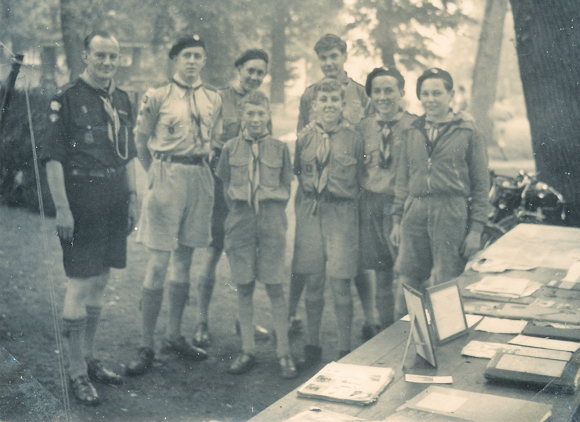
The Troop in Raphael's Park with their International Scouting Display which was part of the District's Coronation Display.
|
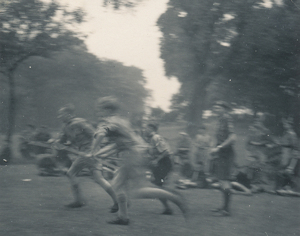
The 3GP Team in the Treck Cart Race
|
The troop took part in the Coronation displays in Raphael Park and Harold Hill, building huts and setting up displays on International Scouting. The Raphael Park display seems to have been arranged by the District with the DC Bill Archer in Charge. Bunny Warren's History of Scouting in Romford states the following:
This included a trek cart race in which teams of Senior Scouts raced to a start line with a trek cart loaded with pioneering gear and rucksacks, constructed a (partly prefabricated) bridge, dismantled the trek cart and carried it over the bridge together with the rucksacks, dismantled the bridge, re-assembled and loaded the trek cart and raced to a finish line. Teams accomplished this in less than fifteen minutes. Wolf Cubs, Scouts and Rovers also took part and our entire display lasted 1½-2 hours.
|
|
| SPORTS Before the Romford District Scouts Swimming Gala, the troop entered the Romford Town Swimming Gala where they won 6 medals. We weren’t the only Scout troop who took part as 3GP lent two Scouts for another troop’s relay team.
This event seems to have been arranged as part of the borough’s Coronation Celebrations. The first four events were between Chase Cross, Hyland and Pettits (Now Marshal’s Park) secondary schools. The next four events were for Romford & District Scouts followed by a synchronised swimming display. This was followed by four events for Romford & District Guides and finally four events for Romford Town Swimming Club. The evening ended with a water polo match.
At the District sports the Scouts won with 24 points and a 5 point margin of victory.
The Troop won the Romford & District Scouts Swimming Gala as did our Cub Pack. The troop scored 36 points and enjoyed a 22 point margin of victory. The October 7th 1953 edition of the Romford Times contains a lengthy event report and an interview with the District Chairman Mr Hay-Davies who explained that 3GP won because we took most advantage of the District's weekly booking of the Romford baths and practiced the most. |
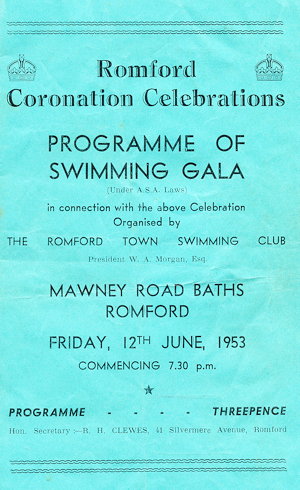 |
|
|
The Group Archive contains a newspaper clipping of an article written by a P. H. C. Dickens about the sport of Polo's chances of survival. One problem for the sport is the lack of younger players coming through, partly due to the cost of participation. The author lists only three young players in the country of “outstanding promise” one of whom was the Duke of Edinburgh. The others were C. Smith Ryland and the final was John Lucas who was a 3GP Cub from 1934 – 1935. He won the Queens cup for polo a successive five times and at one time was in the Guinness Book of records for being the Highest Handicapped English Polo player.
CAMPING
The campsite at Navestock had been abandoned after local vandals burned down the hut. A report of the April trip to Rome can be found here and includes a brief account of how we managed to feature in National newspapers after being robbed while camping outside Rome.
At Whitsun the pre-war district camp at Havering was revived. 3GP sent ten Scouts and two leaders. The Sunday dinner was a banquet lasting one and a half hours and consisted of:
- Pavese Soup (a Bolognese speciality in which eggs are poached and which is then sprinkled with grated cheese)
- Sole a la Colbert (The soles were skinned and filleted in camp and served with anchovies and lemon sauces)
- Roast Guinea Fowl with peas and roast and boiled potatoes
- Treacle Sponge Pudding
- Camp Scones and Cheese.
- Coffee with the beans ground using Scout Staves.
Summer Camp was 600 miles from Gidea Park at Loch Achilty, Strathpeffer in Scotland and a report by Mr Rowswell was published in the September 19th edition of the Romford Recorder. |
|
|
 |
 |
|
 |
 |
 |
1954 |
|
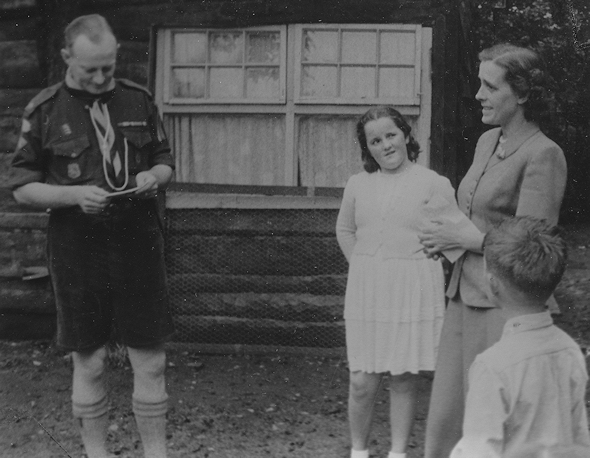
The group annual report for 1954 starts with a description of the Rover Crew log cabin and how it allowed the crew to meet on a weekly basis for the first time. All old Scouts were welcome and the crew grew to 20 members. Old trophies and souvenirs were starting to decorate the walls and so the Den was described as becoming a sort of life size log book.
Also impacting the Crew was the departure of the Crew Leader Bert Hobson, pictured above with Mrs Thompson at the opening of the Den. Bert moved away during 1954. His impact on the group was significant being instrumental in getting the Den renovated and putting on the gang shows.
ANTHONY LEVY
During 1954 the group learned of the passing of Tony Levy. He gave his life rescuing a friend from a crevasse on Mount Olympus Washington State USA.
Scout History Here
Anthony Levy joined the troop in October 1937 having transferred from the Brentwood School Troop. He passed his second class on 5/3/1938 and his first class on 28/2/1939. He was awarded the Bushmanís Thong in July 1939 (First Class Scouts + Camper badge + one of (Explorer, Stalker, or Tracker) + one of (Forester, Naturalist, Pioneer, Starman, Weatherman) Green and Yellow Chords (2nd Class Scout and 6 Proficiency badges) in March 1939, Red and White chords (1st Class Scout and 12 Proficiency badges) in October 1939 and Gold Chords (1st Class Scout and 18 Proficiency badges) in 1941. He also became PL of the cuckoo patrol. It was Tony's family that first provided meeting places for the group when unable
to meet at St Michael's during the war.
Tony was a research chemist who by the age of 30 was leading a department at the university of California. After his death, members of the troop together with Tony’s former patrol second Mr P. Medcraft who by then was A.S.M. of 4th Gidea Park formally dedicated to his memory a sea provided by his mother close to his former home in Heath Close.
|
|
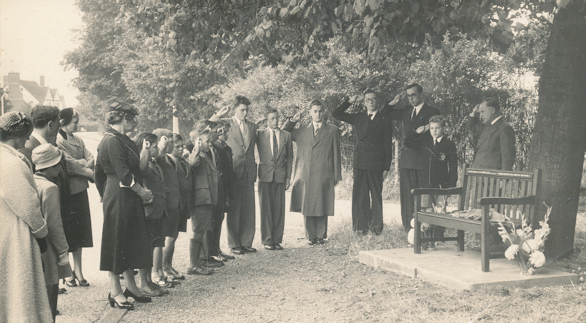
PHOTOGRAPH: Lancelot Vining.
|
|
Dedication of Memorial Seat to Dr. Antony Lewis Levy PhD B.Sc who lost his life in a gallant attempt to save a friend on Mount Olympus Washington USA.
A similar bench stood near by on Main Road near the Nat West Bank (Richer Sounds) which was dedicated to his father Dr Victor Levy who died in 1941.
|
Picture of Tony taken on Summer Camp in 1939.
|
|
CENCUS
A seventh patrol (Herons) was formed as the troop had grown so much. This was in addition to the Cobra patrol. Two of our 56 Scouts were Queens Scouts, 23 were First Class, 23 were Second Class. The County Commissioner awarded the troop a Sea-Axe pennant for an efficient Patrol System.
CAMPS
The Troop held a January Camp in Margaretting and each patrol held a patrol camp at either Easter or Whitsun.
GREECE
In April 3rd Gidea Park became the first troop in its own right (as opposed to being part of a national contingent) to camp in Greece. During this trip the troop made a recording, at the Athens Radio studio of songs and speeches. This was eventually broadcast on May 17th, but could not be received in the UK.

SWITZERLAND
The first August camp was at Schaffhausen and St. Moritz in Switzerland where the Troop camped at 6000ft (1800m) altitude.
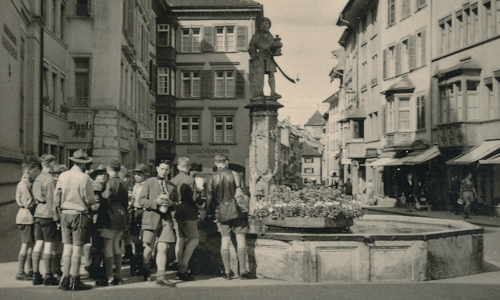
The end of August camp was at Llyn Crafnant. The location on the shore of Llyn Crafnant could have been Cornel Farm Scout Campsite, location of Summer Camp 1992 and Easter Camp 2008.
|
|
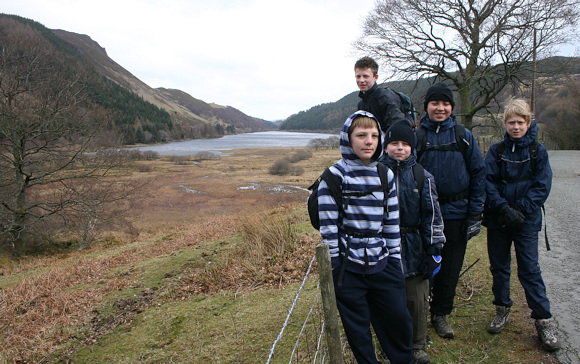
3GP Scouts and Llyn Crafnant - Easter 2008
|
|
The 1954 camp included many walks in the welsh mountains including a 20 mile ramble to the top of Carnedd Llewllyn which at 1061m is the second highest mountain in Wales. They also did a two day hike to the summit of Snowdon where the station staff kindly let them sleep on the station.
Prompted by the experiences in Athens and assisted by Radio Luxembourg, the Troop decided to make a gramophone record. They recorded six songs and one Yell on a ten inch record which was sold by the Group to raise funds.
Several members of the group are noted as helping with the 4th and 8th Romford Groups.
CUBS
The 36 cubs were described in the annual report as being proficient, cheerful and keen. The Assistant Cub Master was absent on National Service and so members of the elite Cobra Patrol were helping with Cub meetings.
|
|
|
 |
 |
|
 |
 |
 |
1955 |
|
|
To celebrate 21 years since the first Scouts were invested at St Michaels, the group held its third show which M.J. Everett produced. Pictures of the production appeared in local papers during March and the group received letters of congratulations from the Mayor.
The Rover Crew now led by Henry Alexander had 20 members and in 1955 won the District Trophy for Adventure, research and service.
The Crew helped out at the carnival with the operation of the childrenís roundabout and other sideshows.
A winter camp at High Rocks near Tunbridge Wells for a climbing course was arranged by John Paisley. |
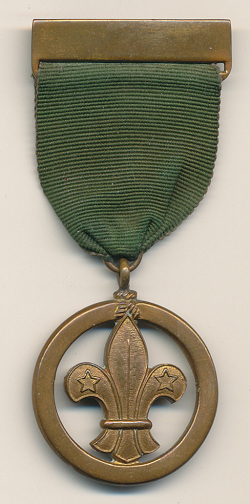 |
On February 16th 1955 F.W. Rowswell was awarded the Medal of Merit by the deputy Chief Scout. These days, the Award for Merit is "Awarded for outstanding service. It implies keen, conscientious, imaginative and dedicated service over a sustained period, of at least 12 years duration."
By 1955 Mr Rowswell had been a warranted leader at 3GP for twenty one years. For large periods of that time he had been the sole leader keeping both the
Scout Troop and cub Pack running. He had been a leader in Portsmouth before that. He was also a leader of the Brentwood School Troop. He had consistently
produced more first class Scouts than any other troop in the district and for a lot of the time more than any other troop in the County. He had helped national
headquarters with international matters and run 15 Troop camps abroad as well as attended one World Scout Jamboree. Some may suggest that 75 years later,
the criteria for the awarding of the Medal of Merit in Romford District is only marginally easier.
|
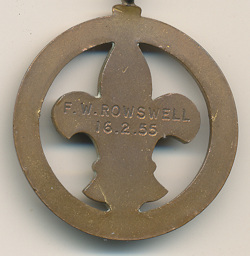 |
|
|
Members
The Troop had 55 members three of whom went up to Rovers at the end of the year. 22 Were first class and 26 second class. The Average age of the troop members were 14 years of age with 21 over 15 years of age. Having a high average age is always regarded as a sign of a good program being run.
CAMPS
The Troop once again made history by being the first UK troop to camp in Malta. This made us the first UK troop to camp in any of the Queens overseas territories. The report for the camp can be found here.
|

3GP and Brentwood Troops in Malta.
|
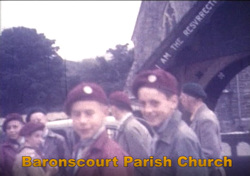 |
The first Summer Camp was in Ulster on the estate of the Duke of Abercorn. His Grace welcomed the troop personally and introduce them to his guest, His Royal Highness The Duke of Kent.
At the end of the camp the troop were given a tour of the Art Treasurers in the house by the Duke and Duchess and Lady Moyra Hamilton. The Station Pub at Liverpool Street (Hamilton Hall)
is named after the Dukeís family as one of his ancestors had been a director of the Great Eastern Railway Company.
|
|
A late Summer camp was enjoyed in rain-less weather at the lovely Bisham Meadow site, on the Thames near Marlow. Plenty of
rowing and cooking was done. The oarsmen successfully navigated several locks reaching Medmenham and Bourne End in the course of their exploration. Cooking was lavish indeed, the dishes including Pavese Soup, Soles Colbert, Anchovy Sauce, Roast and Casserole Scotch Grouse, Treacle Sponge pudding (a real Mrs. Beeton dish) and Eggs Talleyrand (with goose-liver paste and truffles) The cost of feeding on this camp was four shillings and six pence a day; point this out to potential imitators, remarking also. that one shillings worth of meat bones provided all the soup for the whole week, and no tea or butter was bought, on account of high prices.
A week's patrol camp was also arranged in September in the Chilterns.
Expeditions and Explorations
As is the case now, Scouts had to complete over night expeditions to complete the highest badges. As well as facilitating expeditions during camps, expeditions were also run on the North Downs, the Chilterns and Leith Hill and Hindhead Commons.
Awards
A quarter of the year was spent preparing the stage show which left little time for general Scout training and so it wasn't until the end of the year that any first class badges were gained by Five Scouts with John Ames also gaining the rare Scout Cord. In order to maintain quality in the troop it is decided that all Patrol Leaders and Seconds need to be First Class Scouts.
Cubs
Our Cubmaster, Mr W.Clay moved away in the autumn after four years. He was remembered for his keen cub camps and his Swimming teaching for two years. In September the pack welcomed back our assistant cub master, Mr P. Wall, an old Scout of 3rd Gidea Park and former Troop Leader of Forest School. He took over as Cub master but appeared to live in Braintree and had to travel back to 3rd Gidea Park every Tuesday. Scout Instructor John Ames and Rover Instructor David Sixsmith were assisting.
B.P Guild.
The annual report explains the groups desire to start its own B.P Guild. It explains that at this time the Guild was a separate organisation to the Scout Association and unlike Rovers not regarded as a training section.
Sports
The Scouts won the District Swimming gala which included winning the relay race. We also one the top three spots in the Kingswood Cup which at the time was awarded for combined diving swimming and life saving. The event was reported in both the Romford Recorder and the Romford Times.
|
|

John Baskerville of 3rd Gidea Park receiving the trophy on behalf of Romford District, for winning the County Swimming Gala. The Trophy is being presented by Colonel Vaux ACC for Scouts. The event took place at Hutton Residential School.
|
|
The county swimming Gala was contested for the first time in five years. Half of the Romford team were from 3rd Gidea Park as was a member of the Brentwood team. Romford won and Brentwood came second. Squirrels Heath were 3rd. |
|
|
 |
 |
|
 |
 |
 |
1956 |
|
|
Once again we have a group annual report in the archives to learn from.
B.P. Guild
As planned, the group registered a branch of the B.P. Guild. The founder members of the branch were the group committee. As Rovers met retirement age they could move on to the guild which had no upper age.
Notable Alumni
John Paisley is mentioned as having sailed on R.R.S. "Shackleton" for Antarctica and in November was appointed Base Leader of Deception Island, Grahamland, and was sworn in as a Magistrate for this purpose. Over 50 years later he explained to the Scouts at our Christmas Lunch that it was his time as a Scout that gave him his taste for adventure. Several local papers reported his appointment and membership of 3rd Gidea Park.
Crew Camps
Members of the Crew spent Whitsun week in Snowdonia climbing. This culminated in a three-pronged advance to the summit of Snowdon. In July, another group of Rovers carried out a rowing venture from Reading to Pinkhill Lock above Oxford. Between this expedition and that of 1953 the Crew had now navigated the whole of the Thames above the tidal limit.
Members of the Crew were at Gilwell in April for the South-Eastern Counties Rover Moot and at the London Over The Border Moot at Stock in October where the Group Scout Master, Mr Rowswell was a guest speaker. The Crew were back at Gilwell in November helping run a District Patrol Leaders' course.
Crew Dinner
This annual report contains the first mention of the Crew Dinner. The Dinner was believed to be held for the first time in 1954 in a member's house but this was the first time it appears to have taken place in the new Den. The format of the event evolved from time to time but continued as an annual Christmas meal for 65 years until 2019, after which the global Covid pandemic disrupted things somewhat.
The Troop
The numbers were down to 40 from 50 the year before partly because people moved away from the borough and partly, in Mr Rowswell's opinion, because members had taken advantage of the troop for a trip abroad and then left. 18 of the Scouts were First Class and 17 were second class. The average age was still 14 and a half.
Examination demands had caused both our Assistant Scout Masters to leave but Mr W. Meakins had joined as Bo’sun. So in ten years we had gone from 3 leaders and 20 Scouts to 2 leaders and 40 Scouts. The position of Troop Leader was handed over from Jon Day to Vernon Hood.
The First Class badge was gained by Alan Rogers, Michal Gran, Rodney Panting, Alfred Want and Roy Finney. Roy Finney and Graham Meakins gained the rare Scout Cord. Due to the reduction in members we reduced the number of patrols. This also enabled us to ensure that every Patrol Leader and Assistant Patrol Leader had attained at least First Class.
Sports
The swimming gala was won for the eighth successive year with a total of 36 points. With a 12 point lead over the second place troop. In an attempt to encourage other groups who were less successful at retaining older Scouts, the trophy was allegedly awarded based purely on the scores of the younger Scouts. In the district sports we came second, 6 points behind the winners and 24 points ahead of third place.
Some of our Scouts participated in the Brentwood School Troop’s regatta on the Richmond-Toddington course in July. This prompted the troop to try its own regatta but the appointed day in August was a wash out with one team of Scouts warming up with tea on Eel Pie Island and drying out in the hot house at Kew.
The Rovers organised a night wide game for the Scouts in July. The Scouts enjoyed it so much that the Cobra patrol organised another in October which finished with a camp in Fryerning.
Camps
|
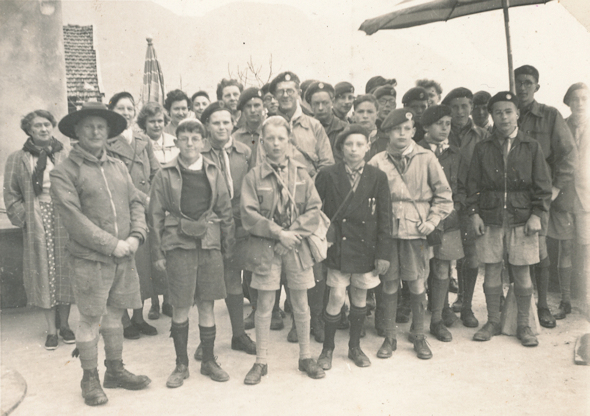
Merano (Tirolo Village) April 1956 |
|
In April, 13 Scouts toured the Austrian and Italian Tyrol, Lake Garda and Venice. Experience the previous year with rapid pitching and packing of tents encouraged the troop to use several sites for four days each. They passed through Switzerland and Lichtenstein, over the Arlberg and Brenner passes to Merano in Northern Italy. Tents were pitched after dark alongside the river Adigo with the help of local Scouts and Rovers who met us on arrival. The weather was dry, but cold winds swept down from the two and a half thousand, meter peaks and the Scouts had to erect stone windbreaks around each tent. They warmed up in the evenings in the adjacent Marlingerhof where lovely white wine could be brought for 4p a glass.
In the English Church we held an Evensong conducted by Rev. D. Rooke, Vicar of Stratford and G.S.M of the 45th West Ham. It was the first service to be held there since 1928. The 1st Merano Catholic Scouts had restored the building making it their HQ but leaving the chancel available for worship.
The group then progressed to Riva on Lake Garda where they camped surrounded by Oliva groves. The weather was fine and allowed swimming and rowing on the lake. Some of the Scouts sailed 35 miles to Sirmino at the southern end of the lake, to view the alleged villa of the Roman poet Catullus.
Finally the camp moved to Venice where the troop sailed on a municipal launch down the Grand Canal and across the Lagoon to the Lido. The troop took a trolleybus to the intended camp site at Malamocco only to find it was basically shut with no running water. This was despite the owner’s letter to us assuring us all would be ok. The Scouts pitched tents in the dark but left first thing in the morning, very thirsty and travelled around looking for another camp site. Eventually an excellent site was found near Mestro Station. The troop had got in the habit of always leaving someone on site looking after our kit but this site was so good they were able to leave the tents and sightsee together. After spending a day sightseeing around Venice the group filled the English Church for Mattins, feeling rather honoured that a chaplain was summoned from Florence for us.
At Whitsun a patrol camp at Gilwell earned a commendation from John Sweet. John wrote books on Scout Pioneering and wrote regularly for Scouting Magazine.
|
|
August In Oakhampton
The first August camp was held in Oakhampton on the slopes of Dartmoor. The Scouts were able to turn part of the West Okement stream into a bathing pool. The weather was generally fine however there was a storm one night which resulted in two leaders being up half the night cutting saplings to turn into fresh tent pegs.
It seems that a lot of hiking was undertaken starting with Church Parade. The parade itself was one and a half miles long but was followed by a ten mile hike that took the Scouts over Yes Tor and High Willhays and back via the Meldon Gorge.
On the Monday they visited the Lydford Gorge and waterfall. The next two days were spent on an overnight hike to the centre of Dartmoor.
|
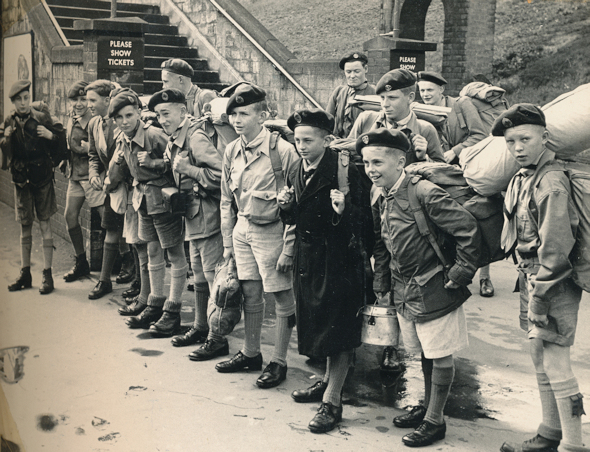
Picture taken for the Romford Times at Gidea Park Station on August 23rd. This was probably the troop leaving for Switzerland. |
|
Late August in Switzerland
Later in the month the Scouts were off to Switzerland again. They headed for Vevy on Lake Geneva but took the Funicular railway up to Mont Pelerin (810m) before carrying all their equipment few hundred meters higher, almost to a summit. The campsite was an alpine meadow backed by pine woods from which could be seen most of the lake and the Jura 50 miles away.
Brian Hood was the camp quartermaster assisted by Allen Matthews who arrived at camp while on leave from National Service with the British Army of the Rhine in Germany. Allen later recounted that when given leave from National Service you were encouraged to travel Germany. Anyone caught nipping back to the UK would be in deep trouble. But nobody was checking that you didnít cross the border to Switzerland to join your old Scout Group for summer camp!
The camp started with a wet few days and when at last the sun did shine on the fourth day, it was only because the camp site was now above the clouds. The troop moved on to Champery (1033m) which is dominated by the 3000m peaks of the Dents du Midi. They arrived in torrential rain and had to spend the first night in an evacuated cow shed. The following day they setup camp in the pinewoods next to the Grand-Paradis Chalet.
They hiked to the Susanfe pass (2493m) spotting a Marmot on the way. They also ascended Planachaux via aerial cableway. One day they hired a motor coach which took them around 50 hair-pin bends to get to Martingny, the Forclaz Pass and Argentiere from where they were able to approach the Mont Blanc glaciers.
On the last day in Switzerland they attended a service at the English church in Vevey, swam in the lake and visited the castle at Chillon.
By year end, the leaders were concerned that only 31 Scouts had managed to camp for a week or more, which was the lowest total since the end of the war. However if Rovers camps were included in the tally then it becomes the highest total of Scouts camping for a week or more since 1949. They also comment that having not enough leaders is the limiting factor and it would have been impossible to accommodate more Scouts on some camps.
Cubs.
The Cub Pack was full and the waiting list only open to members of the parish. The Cub Master Peter Wall was helped by several rovers to run a cub camp at Margaretting for a long weekend in August. When Robin Heffer was released from his National Service in the R.A.F. he took up an assistant Cubmaster warrant.
Progress was noted as being made in several cub badges but it hadnít been possible to teach Cubs to swim which was starting to have a knock on effect when teaching Scouts lifesaving skills.
Leaders
The group was represented at the County conference and at a garden party organised at Lambeth Palace by the Diocese of Gibraltar. The leaders were in contact with Scouts in Hungary at a time when the Communist Hungarian government had abolished Scouting and people could be arrested for participating in Scouting. The leaders were also in contact with Scouts in Spain at a time when Francoís government had officially disbanded Scouting in the country.
One of the cub leaders was noted as commuting from Braintree for meetings.
The Church.
8 Scouts were recorded as being confirmed by the bishop during the year. To commemorate 21 years of the Group, the group gifted to the church an oak cupboard for hymn books which was dedicated at the October Church parade. |
|
|
|
 |
 |
|
 |
 |
 |
1957 |
|
|
1957 was the Scout Movement's Jubilee Year, celebrated with a World Scout Jamboree in the UK. The Group report for 1957 opens by stating that a lack of leaders is holding us back. We had our own paid up branch of the B.P. Guild. Peter Hunt's exploits editing films for TV are mentioned as is John Day who was by now the Secretary of Queen Mary College, London's Scout & Guide Club. Vernon Hood is recorded as representing 3GP at Exeter University.
Rover Crew.
The Crew now had ten members with Paul and Allen Matthews acting as Rover Mates for the year. Allen had by now been released from the British Army of the Rhine and had become Scout Leader of the 19th Romford Scout Group. Normal Meakins had returned from the R.A.F. and promptly took on the task of Medical Officer at the Troop Camp in Scotland.
|

The 19th Romford Troop with 3rd Gidea Park's Allen Matthews 2nd from left.
Standing 6th from left is future 3GP Rover Bob.
|
|
It is recorded that the Crew made what were described as "Ornamental gates for the new District Training Ground in Dunton Road" A quick look at Google maps will show that Dunton Road is the road behind the current District Headquarters. Access from Dunton Road has now been sealed off and replaced with a plain concrete fence.
At the end of May the Crew camped for a week in North Wales during which they climbed several peaks including the Glyders. In July they spent a week camping at Whaley Bridge in the Peak District with our first Rover Scout Leader Albert Hobson. This included an overnight expedition to Kinder Scout.
The crew twice camped at Gilwell, first for a work weekend in August and again in November where they were chief cooks for the District Patrol Leaders course.
The 1957 Group annual report makes mention of the "The Woggle" which was the Crew newsletter (Published regularly at irregular intervals) It appears copies were sent to "The Scouter" as John Paisley's report from Deception Island Base in Antarctica got a special mention. Brewing wine and making wicker baskets were other activities undertaken.
The Troop
The troop now had 38 Scouts arranged in five patrols, down from six the previous year. The Troop recorded its first Queens Scout Award for four years, achieved by John Ames. First Class badges were gained by Malcolm Pearce, Ian Barrett, Peter Baxter, Nigel Gibson, David Goss and Richard Stringer. All seven acquired Patrol Second's (APL) Stripes. In addition the Scout Chord was gained by Peter Baxter, Richard Stringer, Michael Gran and Alan Rogers. David Sharp is noted as emulating Michael Kennedy in qualifying for an Air Pilot's Licence.
John Seely is noted as having set new standards in the troop by getting his Interpreter badge for Italian. It seems he had a state scholarship to university at the age of 16.
In January the troop visited the Science and Natural History museums in London. During January the troop participated in an event that to a modern Scout Leader sounds like a paperwork nightmare, an all day wide game stretching out to Stapleford Abbots and Navestock.
In April, 3rd Gidea park sent more Scouts than any other troop, 5 Scouts, to the county training course for Senior Scouts in Brentwood. This course is credited with helping John Ames get his Queens Scout Award.
The April joint camp with Brentwood School took us to Florence and Sori in Italy and Menton in France. The first and last of these were municipal sites near the town centres with every facility laid on especially at Florence where there was a laundering trough and power outlets for electric razors. The Scouts paid a visit to the art galleries in Florence, the Roman theatre at Fiesole and the churches including a Palm Sunday service in the English Church. Half a day was spent at Pisa where the tower was climbed. The troop had done this previously in 1953 but this time was better as they timed the visit to be able to hear noon being struck on the bronze bell at the top.
This was the third time in six years that the troop had camped at Sori in Italy, this time in the grounds of Countess Gigliucci’s Villa which was next to the Scout’s Hunting Lodge which was at the time occupied by the 1st Headington (Oxford) Girl Guides. We were once again warmly welcomed by Orazio Sommi, the commissioner for North-West Italy. The Scouts also enjoyed a campfire with local scouts right by the blue sea.
The scouts had to walk across the border between Italy and France at Menton having arrived by bus. This was due to a two day French rail strike. The campsite was on a hilltop in a park of Olives, camphor trees and Australian blue gum. The Scouts were serenaded nightly by Frogs and cicadas. The Scouts hiked the peaks of the frontier and visited the Monaco Aquarium. On Easter Sunday the Scouts attended Mass at the English Church in Menton.
Understandably, the two municipal sites wouldn’t allow fires for cooking so for the second year in a row the Scouts experimented with using paraffin stoves. They managed to cook squid and Octopus but by the end of camp, the stoves were in need of an overhaul. The regular cry of “Fan the Fire” having been replaced with “pump the stove!” but pumping was by now having little effect.
Whilst camping at Menton, the Scouts discovered that Erik Hopkin, an old member of the troop was staying in the hostel next door. |
|
|
 |
 |
|
 |
|

































